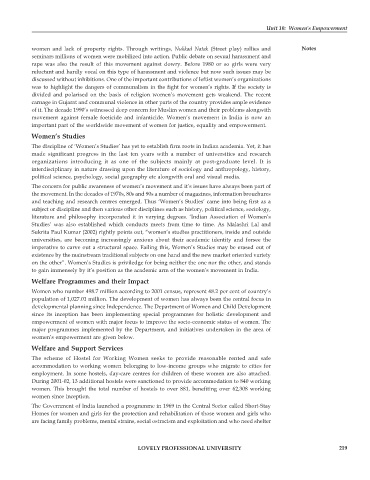Page 224 - DSOC202_SOCIAL_STRATIFICATION_ENGLISH
P. 224
Unit 10: Women's Empowerment
women and lack of property rights. Through writings, Nukkad Natak (Street play) rallies and Notes
seminars millions of women were mobilized into action. Public debate on sexual harassment and
rape was also the result of this movement against dowry. Before 1980 or so girls were very
reluctant and hardly vocal on this type of harassment and violence but now such issues may be
discussed without inhibitions. One of the important contributions of leftist women’s organizations
was to highlight the dangers of communalism in the fight for women’s rights. If the society is
divided and polarised on the basis of religion women’s movement gets weakend. The recent
carnage in Gujarat and communal violence in other parts of the country provides ample evidence
of it. The decade 1990’s witnessed deep concern for Muslim women and their problems alongwith
movement against female foeticide and infanticide. Women’s movement in India is now an
important part of the worldwide movement of women for justice, equality and empowerment.
Women’s Studies
The discipline of ‘Women’s Studies’ has yet to establish firm roots in Indian academia. Yet, it has
made significant progress in the last ten years with a number of universities and research
organizations introducing it as one of the subjects mainly at post-graduate level. It is
interdisciplinary in nature drawing upon the literature of sociology and anthropology, history,
political science, psychology, social geography etc alongwith oral and visual media.
The concern for public awareness of women’s movement and it’s issues have always been part of
the movement. In the decades of 1970s, 80s and 90s a number of magazines, information brouchures
and teaching and research centres emerged. Thus ‘Women’s Studies’ came into being first as a
subject or discipline and then various other disciplines such as history, political science, sociology,
literature and philosophy incorporated it in varying degrees. ‘Indian Association of Women’s
Studies’ was also established which conducts meets from time to time. As Malashri Lal and
Sukrita Paul Kumar (2002) rightly points out, “women’s studies practitioners, inside and outside
universities, are becoming increasingly anxious about their academic identity and forsee the
imperative to carve out a structural space. Failing this, Women’s Studies may be erased out of
existence by the mainstream traditional subjects on one hand and the new market oriented variety
on the other”. Women’s Studies is priviledge for being neither the one nor the other, and stands
to gain immensely by it’s position as the academic arm of the women’s movement in India.
Welfare Programmes and their Impact
Women who number 498.7 million according to 2001 census, represent 48.2 per cent of country’s
population of 1,027.01 million. The development of women has always been the central focus in
developmental planning since Independence. The Department of Women and Child Development
since its inception has been implementing special programmes for holistic development and
empowerment of women with major focus to improve the socio-economic status of women. The
major programmes implemented by the Department, and initiatives undertaken in the area of
women’s empowerment are given below.
Welfare and Support Services
The scheme of Hostel for Working Women seeks to provide reasonable rented and safe
accommodation to working women belonging to low-income groups who migrate to cities for
employment. In some hostels, day-care centres for children of these women are also attached.
During 2001-02, 13 additional hostels were sanctioned to provide accommodation to 840 working
women. This brought the total number of hostels to over 881, benefiting over 62,308 working
women since inception.
The Government of India launched a programme in 1969 in the Central Sector called Short-Stay
Homes for women and girls for the protection and rehabilitation of those women and girls who
are facing family problems, mental strains, social ostracism and exploitation and who need shelter
LOVELY PROFESSIONAL UNIVERSITY 219

